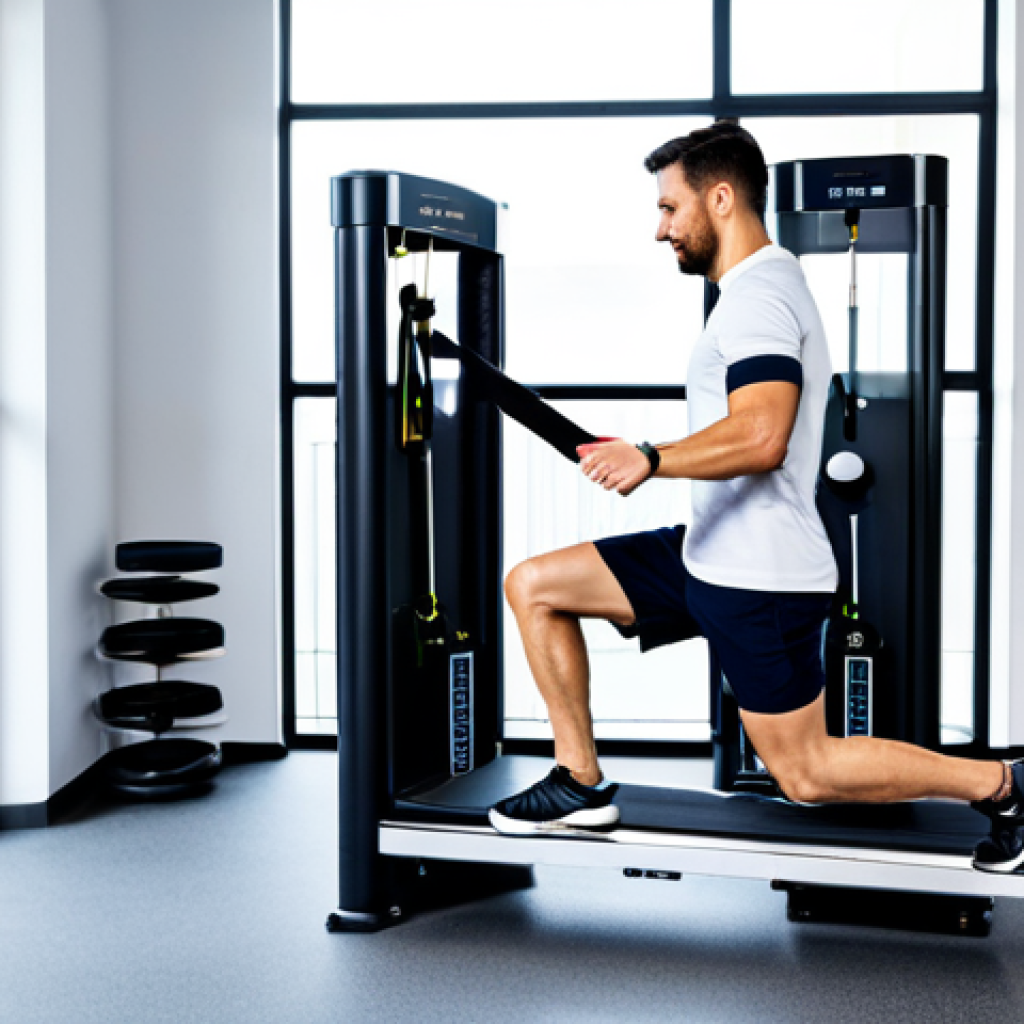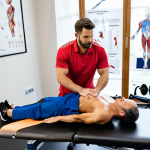The world of sports rehabilitation is constantly evolving, driven by cutting-edge research and innovative techniques. As a seasoned sports rehab professional, I’ve witnessed firsthand the transformative impact of evidence-based practices on athlete recovery and performance enhancement.
Recent studies are increasingly focusing on personalized rehabilitation programs tailored to individual biomechanics and injury profiles, moving away from the one-size-fits-all approach.
Moreover, the integration of wearable technology and data analytics is providing unprecedented insights into movement patterns and training loads, allowing for proactive injury prevention strategies.
From advanced manual therapy techniques to the application of virtual reality in rehabilitation, the future of sports rehab is incredibly exciting. The convergence of regenerative medicine and exercise science also holds immense promise for accelerating tissue healing and restoring optimal function.
Let’s delve deeper into these fascinating advancements in the article below.
## Navigating the Labyrinth of Return-to-Sport ProtocolsAs sports rehab professionals, we often find ourselves at the crossroads of science and art when guiding athletes back to their respective arenas.
The return-to-sport (RTS) process is far from a linear path; it’s a complex, multifaceted journey requiring meticulous planning, constant evaluation, and, above all, a deep understanding of the athlete’s individual needs.
I’ve noticed that many clinicians, especially those newer to the field, tend to rely heavily on generic protocols. While these can provide a useful framework, they often fall short in addressing the unique biomechanical, psychological, and physiological demands of each sport and athlete.
A basketball player recovering from an ACL reconstruction, for example, will have vastly different requirements compared to a marathon runner with a stress fracture.
The Pitfalls of Chronological vs. Criteria-Based Progression

One of the biggest debates in RTS revolves around chronological versus criteria-based progression. Chronological progression, where athletes advance based on time elapsed post-injury, can be risky.
I’ve seen too many athletes re-injured because they were pushed forward based on a predetermined timeline, not on their actual functional capacity. Criteria-based progression, on the other hand, focuses on achieving specific milestones in strength, range of motion, agility, and sport-specific skills.
This approach allows for greater flexibility and personalization, ensuring that athletes are truly ready for each stage of rehabilitation. In my experience, a hybrid approach – using time as a general guideline while prioritizing criteria-based advancement – yields the best results.
Quantifying Readiness: Objective Measures and Subjective Feedback
So, how do we objectively determine an athlete’s readiness to progress? We need to move beyond simple clinical assessments and incorporate quantifiable measures.
Force plates, for instance, can provide invaluable data on jump landing mechanics and limb symmetry, helping us identify subtle deficits that might not be apparent during visual observation.
Isokinetic dynamometry allows for precise measurement of muscle strength and power at various speeds, which is crucial for assessing functional capacity.
Equally important is the athlete’s subjective feedback. Open communication and trust are paramount. I always make it a point to ask athletes about their pain levels, their confidence in their abilities, and any fears or anxieties they might have about returning to competition.
Ignoring these subjective factors can be detrimental to the RTS process.
Mastering the Art of Load Management
Load management is a critical aspect of sports rehabilitation, particularly during the return-to-sport phase. It’s about finding the sweet spot between pushing athletes to improve and preventing overtraining or re-injury.
In the past, I’ve made the mistake of increasing training volume or intensity too quickly, only to see athletes regress due to overuse syndromes. Now, I take a much more systematic and data-driven approach.
External vs. Internal Load: A Holistic Perspective
Understanding the difference between external and internal load is crucial. External load refers to the objective, measurable aspects of training, such as distance covered, weight lifted, or sprint speed.
Internal load, on the other hand, reflects the physiological and psychological stress imposed on the athlete by that external load. This includes factors like heart rate variability, perceived exertion, and sleep quality.
Monitoring both external and internal load allows us to get a more complete picture of how an athlete is responding to training.
The Role of Technology in Load Monitoring
Wearable technology has revolutionized the way we monitor load. GPS trackers can provide detailed information on movement patterns, distance covered, and acceleration/deceleration metrics.
Heart rate monitors offer insights into cardiovascular stress and recovery. Some devices even track sleep quality, a vital indicator of an athlete’s ability to adapt to training.
I use this data to make informed decisions about adjusting training volume and intensity. For example, if an athlete’s heart rate variability is consistently low, indicating poor recovery, I’ll reduce their training load and focus on strategies to improve sleep and reduce stress.
Individualizing Load Management Strategies
There is no one-size-fits-all approach to load management. What works for one athlete might not work for another. Factors like age, training history, injury history, and individual physiology all play a role.
Some athletes thrive on high-volume training, while others respond better to shorter, more intense sessions. It’s up to us, as sports rehab professionals, to understand these individual differences and tailor our load management strategies accordingly.
Psychological Considerations: The Unseen Barrier
Physical rehabilitation is only one piece of the puzzle. The psychological impact of injury can be profound, and it’s often overlooked. Fear of re-injury, anxiety, depression, and loss of confidence can all hinder an athlete’s return to sport.
I remember working with a young soccer player who had recovered physically from a knee injury but was still hesitant to make sharp cuts or challenge for the ball.
It became clear that his psychological barriers were preventing him from performing at his best.
Addressing Fear and Anxiety
Fear of re-injury is a common obstacle. Athletes may consciously or unconsciously alter their movement patterns to avoid putting stress on the injured area, which can lead to compensatory injuries.
Open communication is key. I create a safe space for athletes to express their fears and anxieties. I also use techniques like visualization and positive self-talk to help them regain confidence in their abilities.
Building Resilience and Mental Toughness
Sports rehabilitation is not just about restoring physical function; it’s also about building resilience and mental toughness. I encourage athletes to focus on what they can control, such as their effort, their attitude, and their adherence to the rehabilitation program.
Setting small, achievable goals can provide a sense of progress and accomplishment. Celebrating milestones, no matter how small, can boost morale and motivation.
The Importance of a Multidisciplinary Approach
Addressing the psychological aspects of injury often requires a multidisciplinary approach. I frequently collaborate with sports psychologists to provide athletes with specialized counseling and support.
Cognitive behavioral therapy (CBT) and other psychological interventions can be highly effective in addressing fear, anxiety, and depression.
The Role of Nutrition in Accelerated Recovery
In my years of experience, I’ve come to appreciate the profound impact of nutrition on recovery and performance. It’s not just about meeting basic caloric needs; it’s about strategically fueling the body with the right nutrients to support tissue repair, reduce inflammation, and optimize energy levels.
Too often, athletes neglect this crucial aspect of their rehabilitation, and it can significantly delay their return to sport.
Protein: The Building Block of Tissue Repair
Protein is essential for muscle repair and growth. After an injury, the body’s protein requirements increase significantly. I typically recommend that athletes consume 1.6-2.2 grams of protein per kilogram of body weight per day, spread out evenly throughout the day.
Leucine, an essential amino acid, plays a key role in stimulating muscle protein synthesis. Foods rich in leucine include meat, poultry, fish, eggs, and dairy products.
Anti-Inflammatory Foods: Taming the Inflammatory Response
Inflammation is a natural part of the healing process, but excessive inflammation can hinder recovery. Anti-inflammatory foods can help to modulate the inflammatory response and promote tissue repair.
Omega-3 fatty acids, found in fatty fish like salmon and tuna, have potent anti-inflammatory properties. Other anti-inflammatory foods include fruits, vegetables, and spices like turmeric and ginger.
Hydration: The Unsung Hero of Recovery
Dehydration can impair muscle function, increase fatigue, and slow down the healing process. Athletes should aim to drink enough fluids to maintain adequate hydration throughout the day.
Water is the best choice for most situations, but sports drinks can be helpful during intense exercise to replenish electrolytes lost through sweat. I often advise athletes to monitor their urine color as a simple way to assess their hydration status.
Embracing Technology: Tools for the Modern Sports Rehab Professional
Technology is rapidly transforming the field of sports rehabilitation. From advanced imaging techniques to wearable sensors and virtual reality systems, we have access to a wealth of tools that can enhance our assessment, treatment, and return-to-sport strategies.
However, it’s important to remember that technology is just a tool. It’s up to us, as sports rehab professionals, to use these tools wisely and ethically.
Diagnostic Imaging: Seeing Beneath the Surface
Diagnostic imaging techniques like MRI, ultrasound, and CT scans provide invaluable information about the nature and extent of an injury. MRI is particularly useful for visualizing soft tissue injuries, such as ligament tears and muscle strains.
Ultrasound is a cost-effective and non-invasive way to assess muscle and tendon injuries in real-time. CT scans are often used to evaluate bone fractures and dislocations.
Wearable Sensors: Tracking Movement and Performance
Wearable sensors, such as GPS trackers, accelerometers, and heart rate monitors, provide real-time data on an athlete’s movement patterns, training load, and physiological response to exercise.
This information can be used to optimize training programs, prevent injuries, and monitor recovery.
Virtual Reality: Immersive Rehabilitation
Virtual reality (VR) is an emerging technology with great potential for sports rehabilitation. VR systems can create immersive simulations of sport-specific activities, allowing athletes to practice their skills in a safe and controlled environment.
VR can also be used to improve balance, coordination, and reaction time. Here’s a summary table highlighting the key aspects discussed:
| Aspect | Key Considerations | Tools & Strategies |
|---|---|---|
| Return-to-Sport Protocols | Criteria-based progression, individualization, sport-specific demands | Objective measures (force plates, dynamometry), subjective feedback, hybrid approach |
| Load Management | External vs. internal load, individual variations, prevention of overtraining | Wearable technology (GPS, heart rate monitors), data analysis, individualized training plans |
| Psychological Considerations | Fear of re-injury, anxiety, confidence, mental toughness | Communication, visualization, goal-setting, sports psychology consultation |
| Nutrition | Protein intake, anti-inflammatory foods, hydration | Balanced diet, omega-3 supplementation, fluid monitoring |
| Technology | Diagnostic imaging, wearable sensors, virtual reality | MRI, ultrasound, GPS trackers, VR systems, data-driven decision-making |
Ethical Considerations: Prioritizing Athlete Well-being
As sports rehab professionals, we have a responsibility to prioritize the well-being of our athletes above all else. This means making ethical decisions that are in their best interest, even if those decisions are not always popular.
Informed Consent: Empowering Athletes
Informed consent is a fundamental ethical principle. Athletes have the right to understand the risks and benefits of any treatment or intervention before they agree to it.
We must provide them with clear, accurate, and unbiased information.
Confidentiality: Protecting Athlete Privacy
Confidentiality is another essential ethical principle. We must protect the privacy of our athletes and not disclose their personal information to others without their consent.
Avoiding Conflicts of Interest: Maintaining Objectivity
Conflicts of interest can arise when our personal interests conflict with our professional responsibilities. For example, if we are being paid by a team or organization to get an athlete back on the field as quickly as possible, we may be tempted to compromise their well-being.
It’s important to be aware of these potential conflicts and to take steps to avoid them. In conclusion, sports rehabilitation is a dynamic and ever-evolving field.
By staying up-to-date on the latest research, embracing new technologies, and prioritizing ethical considerations, we can help athletes recover from injuries and return to sport stronger and more resilient than ever before.
Navigating the world of sports rehab is like conducting an orchestra, where each instrument (or athlete) requires a unique score and the conductor (that’s us!) needs to harmonize individual needs with overarching goals.
The journey back to the field is rarely straightforward, but by combining evidence-based practices with a healthy dose of empathy and personalized care, we can empower athletes to not only recover but thrive.
Let’s continue to learn, adapt, and put athlete well-being at the heart of everything we do!
Wrapping Up
The path to a successful return to sport is multifaceted, demanding a blend of scientific rigor, personalized care, and ethical considerations. We, as sports rehab professionals, must continually strive to enhance our knowledge, adapt to new technologies, and, above all, prioritize the well-being of our athletes. By doing so, we not only facilitate their physical recovery but also fortify their resilience and mental fortitude, preparing them to return stronger and more confident than ever before.
Let’s keep pushing the boundaries of what’s possible in sports rehab, always with the athlete’s best interests at heart!
Handy Tips to Keep in Your Back Pocket
1. Stay Updated on Research: Constantly engage with the latest studies and evidence-based practices to refine your strategies and stay ahead of the curve. Journals like the “Journal of Orthopaedic & Sports Physical Therapy” are goldmines.
2. Leverage Wearable Tech Wisely: Use wearable sensors to gather data, but don’t rely solely on the numbers. Balance quantitative metrics with qualitative insights from the athlete’s experiences. Tools like Garmin and Whoop are useful but should be used in conjunction with athlete feedback.
3. Invest in Psychological Support: Recognize the profound impact of mental health on recovery. Collaborate with sports psychologists or counselors to provide comprehensive care. Resources like the Association for Applied Sport Psychology can be helpful.
4. Emphasize Nutrition Education: Educate athletes on the importance of proper nutrition and hydration. Consult with a registered dietitian to develop personalized nutrition plans. Websites like the Academy of Nutrition and Dietetics offer reliable information.
5. Never Stop Learning: Attend workshops, conferences, and continuing education courses to expand your knowledge and skills. Organizations like the American Physical Therapy Association offer excellent learning opportunities.
Key Takeaways
Individualization is Key: Generic protocols are a starting point, not the finish line. Tailor your approach to meet the unique needs of each athlete. Consider age, training history, injury history, sport and psychology.
Load Management Matters: Balance external and internal load, using technology and athlete feedback to prevent overtraining and re-injury. Track metrics from wearable technology to determine the most effective load management strategy for each athlete.
Psychological Factors are Critical: Address fear, anxiety, and loss of confidence through open communication, visualization, and collaboration with mental health professionals. Ensure the athlete is emotionally ready before returning to competition.
Nutrition Plays a Vital Role: Optimize recovery through adequate protein intake, anti-inflammatory foods, and proper hydration. Consult a registered dietician when developing a personalized nutrition plan.
Technology Enhances Practice: Use diagnostic imaging, wearable sensors, and virtual reality to enhance assessment, treatment, and return-to-sport strategies. However, always prioritize ethical considerations and informed consent.
Frequently Asked Questions (FAQ) 📖
Q: What’s the biggest shift you’ve seen in sports rehab over the last few years?
A: Honestly, it’s the move away from cookie-cutter treatments. I remember back in the day, everyone with an ACL tear got practically the same rehab plan.
Now, we’re using detailed biomechanical assessments and tailoring programs to each athlete’s specific needs and sport. It’s like, finally, we’re treating people, not just injuries!
I recently had a young basketball player who, based on her movement analysis, needed a totally different approach to landing mechanics than I initially planned.
It made all the difference in her recovery.
Q: Wearable tech is everywhere these days. How is it changing how you approach injury prevention?
A: Wearable tech has been a total game-changer for me. I can now see in real-time how athletes are moving, what their training loads are, and even predict potential problems before they turn into injuries.
For instance, a few months ago, I noticed one of my runners’ cadence was dropping and her ground contact time was increasing, according to her wearable data.
Turns out, she was developing a stress fracture, but we caught it early and avoided a major setback. It’s not perfect, of course – you still need a good eye and clinical judgement – but it’s a powerful tool.
I actually had a small scare myself a while back; my own running watch alerted me to some irregular heart activity, and I ended up needing a minor procedure.
Talk about practicing what you preach!
Q: What’s the most exciting thing on the horizon for sports rehabilitation, in your opinion?
A: For me, it’s the convergence of regenerative medicine and exercise science. We’re talking about accelerating tissue healing with things like PRP (Platelet-Rich Plasma) and stem cell therapies, combined with precisely targeted exercise protocols.
Imagine being able to rebuild damaged cartilage or accelerate tendon healing to get athletes back on the field faster and stronger than ever before. It’s still early days, but the potential is huge.
I’m particularly interested in the use of biofeedback during exercise to optimize muscle activation after surgery; I’ve seen some promising preliminary results that are really inspiring.
It’s an incredibly exciting time to be in this field!
📚 References
Wikipedia Encyclopedia






